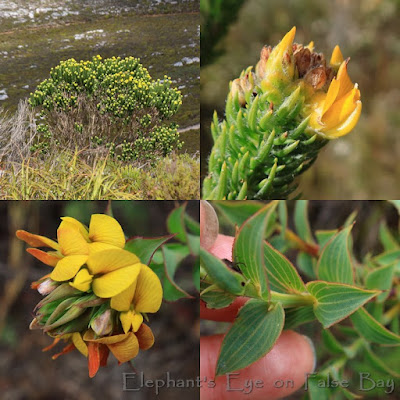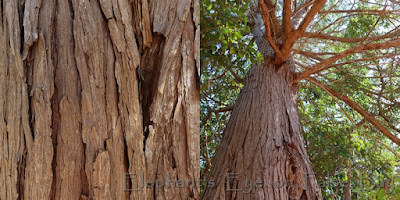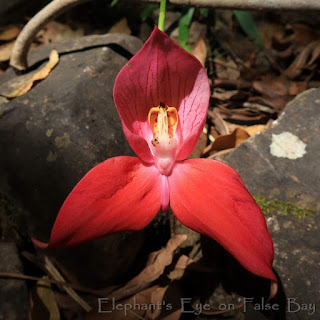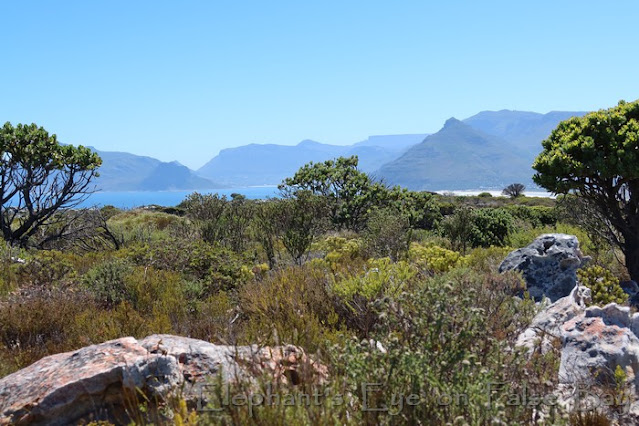February hikes to Silvermine, Kirstenbosch and Slangkop
by Diana Studer
- gardening for biodiversity
in Cape Town, South Africa
Hiking among wildflowers
in the mountains
around Cape Town
We begin at Silvermine Crags along the ridge hoping for Aspalathus capitata. One solitary blooming bush, too far below the path among rocks and tall shrubs. A single flower next to the path. Aspalathus crenata, with pale veins in the leaves, was more flowery.
 |
| Aspalathus at Silvermine in February |
Spider with a stabilimentum, not the neatest zigzag stitch from Argiope australis. Quiet beige flowers opening to pink flashes Tritoniopsis unguicularis. Phylica dioica has little white starry flowers. Phylica imberbis showing the more typical Phylica leaves with rolled under margins.
 |
| With Phylica at Silvermine in February |
Kirstenbosch up up up thru the forest for the trees. Mountain cedar Widdringtonia nodiflora was too big to hug my arms around.
 |
| Widdringtonia nodiflora |
Red pear Scolopia mundii has buttress roots.
 |
| Scolopia mundii |
Reminder to mountain bikers - slow walkers are us! Fern and moss in the forest, up in the kloof bordering Kirstenbosch. But I missed most of the tree lesson, as one of our hikers had to turn back. Then we pair of backstops had a brisk march to catch the others. We were on the upper contour path halfway up the mountain. Looking down across montane fynbos at the managed garden with its irrigation dam. Our home lies behind distant Steenberg mountain.
 |
| Kirstenbosch forest |
Destination Disa uniflora, last year that same plant was carrying its flower disconcertingly upside down. Disas favour rock outcrops and cliffs, which brought down our second hiker.
 |
| February is Disa month Disa uniflora at Kirstenbosch |
Back to Silvermine towards Junction Pool, but thunder and lightning sent us home early. "Sit DOWN, Diana - you'll be struck by lightning" (Started 2 small mountain fires, but not near our hike!) Vivid blue Disa graminifolia. Lobelia setacea white with purple flashes. On this slope is a population of green Erica urna-viridis. Glowing gold and endemic to Southern Cape Peninsula Serruria villosa.
 |
| February flowers at Silvermine towards Junction Pool |
Ending at Slangkop. First target Brunsvigia orientalis and Haemanthus sanguineus (unspotted flowerstalk) both having a better year. Tritoniopsis triticea. Succulent Tylecodon grandiflorus.
 |
| RED flowers at Slangkop in February |
Second target Erica ferrea (similar to corifolia but this time) with dark dots on the tips of the sepals. Dianthus albens which is usually pink. Blue magic Roella ciliata. Pink daisy, each flower with a single pink petal Disparago ericoides.
 |
| Pink and blue at Slangkop in February |
From Slangkop we look back at Noordhoek beach, Chapman's Peak, Hout Bay, and half of Table Mountain.
 |
| Looking from Slangkop to Table Mountain |
My hikes are listed on my page.
I invite you to join us at Elephant's Eye on False Bay. Please subscribe as you prefer
via Feedly,
or my Facebook blog page
Pictures by Diana Studer
of Elephant's Eye on False Bay
Teal blue text is my links.
To read comments if you are in a Reader,
first click thru to the blog)
Thanks for comments that add value. Your comment will not appear until I've read it. I welcome comments on posts from the last 2 months.
Google and Blogger comments uncooperative? Use Name / URL instead.

Lovely shots!
ReplyDeleteSuch gorgeous flowers. xo Laura
ReplyDeleteEvery time I think you can't possibly come up with new plants to share you produce dozens of them. I LOVE that Disa graminifolia but there are many others I'd be thrilled to see in person.
ReplyDeleteWhat Kris said. And for some reason (the lagging winter here, the need for warmth?), the red/orange blooms in your post are speaking to me. The Disa uniflora is stunning!
ReplyDeleteSo lovely. I'm constantly amazed by the variety of plants in your part of the world.
ReplyDeleteAmalia
xo
Serruria villosa. Love that! As usual amazing wealthy of amazing species. Thank you so much for taking us along via the photos.
ReplyDeleteHere at home reveling in the beauty of Leucadendrons and Leucospermums!